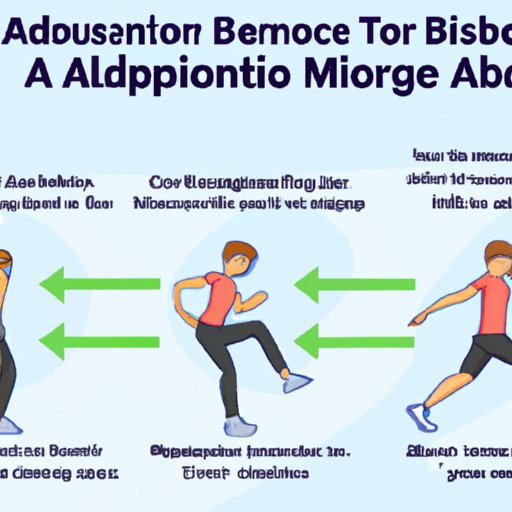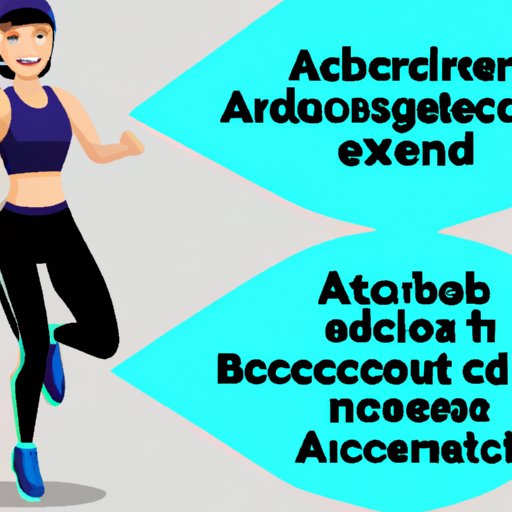Introduction
Aerobic exercise is any type of physical activity that uses large muscle groups in a repetitive motion for an extended period of time. It requires the body to use oxygen to produce energy, as opposed to anaerobic exercise which does not require oxygen. Aerobic exercise is often referred to as “cardio” because it strengthens the cardiovascular system. Examples of aerobic exercise include jogging, swimming, cycling, walking, and dancing.
Aerobic exercise has numerous health benefits. It can improve heart health, lower blood pressure, increase lung capacity, reduce stress levels, and help with weight loss. It can also help to build muscle, increase energy levels, and boost mood. In addition, regular aerobic exercise can help to prevent chronic diseases such as diabetes, stroke, and some forms of cancer.

How to Incorporate Aerobic Exercise into Your Routine
Incorporating aerobic exercise into your daily routine is essential for reaping the many benefits associated with it. Here are some tips to get started:
Make it Part of Your Lifestyle
The best way to make sure you stick with aerobic exercise is to make it part of your lifestyle. Find activities that you enjoy doing and make them part of your daily routine. For example, if you like running, set aside some time each day to go for a run. If you prefer taking walks, try to find ways to incorporate more walking into your day.
Find the Right Exercise for You
It’s important to find the right type of exercise for you. Different people have different needs and preferences when it comes to exercise, so it’s important to find something that works for you. Take some time to explore different activities and find one that you enjoy doing and that fits into your lifestyle.
Set Goals and Track Progress
Setting goals is a great way to stay motivated and track your progress. Start by setting small, achievable goals and then gradually increase them as you become more comfortable with the activity. Tracking your progress is also important; this will help you to see how far you’ve come and keep you motivated to continue.
Tips for Getting Started with Aerobic Exercise
Getting started with aerobic exercise can be intimidating, but with the right attitude and preparation, it can be enjoyable and beneficial. Here are some tips to help get you started:
Start Small
When starting out, it’s important to take it slow and start small. Begin with short workouts and gradually increase the intensity and duration as you become more comfortable. Don’t rush into intense workouts; instead, focus on building up your endurance and strength over time.
Warm Up and Cool Down
Before beginning any workout, it’s important to warm up your muscles and joints. This helps to prevent injury and prepare your body for the exercise ahead. After your workout, it’s equally important to cool down and stretch. This helps to restore your muscles and reduce any soreness or stiffness.
Listen to Your Body
It’s important to listen to your body and pay attention to how it feels during and after your workouts. If you feel any pain or discomfort, stop immediately and consult a doctor. It’s also important to know when to push yourself and when to take a break; don’t be afraid to take a day off if your body needs it.
Different Types of Aerobic Exercises
There are many different types of aerobic exercise, so it’s important to find one that works for you. Here are some of the most popular types of aerobic exercise:
Low Impact Cardio
Low impact cardio is a good option for those just getting started with aerobic exercise. Examples of low impact cardio include walking, swimming, and using an elliptical machine. Low impact cardio is easier on the joints and can be done for longer periods of time compared to high intensity activities.
High Intensity Interval Training (HIIT)
High intensity interval training (HIIT) is a type of aerobic exercise that alternates between high intensity bursts of activity and brief rest periods. HIIT is an effective way to burn calories and build endurance in a shorter amount of time. Examples of HIIT include sprinting, burpees, and jumping jacks.
Strength Training
Strength training is another type of aerobic exercise that can help to build muscle and increase strength. Examples of strength training include weightlifting, bodyweight exercises, and resistance bands. Strength training can be done in combination with other aerobic activities to create a well-rounded workout routine.
Yoga
Yoga is an ancient practice that combines physical poses with breathing exercises and meditation. It is a great way to build strength, increase flexibility, and relax the mind. There are many different types of yoga, so it’s important to find one that works for you.
Understanding the Science Behind Aerobic Exercise
To understand the science behind aerobic exercise, it’s important to understand the role of oxygen, muscles, and energy production. Here is a quick overview:
The Role of Oxygen
Oxygen is essential for aerobic exercise because it helps to provide energy to the muscles. During exercise, oxygen is used to convert glucose into energy. This energy is then used by the muscles to contract and move the body.
The Role of Muscles
Muscles play an important role in aerobic exercise. When muscles contract, they use oxygen to produce energy. As the intensity of the exercise increases, the demand for oxygen increases. This is why it’s important to take breaks during aerobic exercise to allow the muscles to rest and recover.
The Role of Energy Production
Aerobic exercise relies on the body’s ability to produce energy efficiently. During exercise, the body produces energy in the form of adenosine triphosphate (ATP). ATP is then used by the muscles to contract and move the body. The more efficient the body is at producing energy, the more efficient the muscles are at contracting and moving the body.

The Benefits of Combining Aerobic and Anaerobic Exercise
Combining aerobic and anaerobic exercise is an effective way to maximize the benefits of both types of exercise. Here are some of the benefits of combining aerobic and anaerobic exercise:
Improved Cardiovascular Health
Regular aerobic exercise can help to improve cardiovascular health by strengthening the heart and increasing the body’s ability to pump blood efficiently. Combining aerobic and anaerobic exercise can further improve cardiovascular health by increasing the body’s ability to use oxygen more efficiently.
Increased Muscle Mass
Regular aerobic exercise can help to build muscle mass and strength. Combining aerobic and anaerobic exercise can further increase muscle mass and strength by recruiting different muscle fibers. This can help to improve athletic performance and reduce the risk of injury.
Reduced Risk of Injury
Regular aerobic exercise can help to reduce the risk of injury by strengthening the muscles and improving flexibility. Combining aerobic and anaerobic exercise can further reduce the risk of injury by increasing the body’s ability to handle higher levels of intensity.

Five Simple Ways to Incorporate Aerobic Exercise into Your Life
Incorporating aerobic exercise into your life doesn’t have to be complicated or time consuming. Here are five simple ways to get started:
Take the Stairs Instead of the Elevator
Taking the stairs instead of the elevator is a great way to add a little bit of aerobic exercise to your day. It’s a low impact activity that can help to improve cardiovascular health and burn calories.
Go for a Walk or Bike Ride
Going for a walk or bike ride is a great way to get outside and get some exercise. It’s also a great way to explore your local area and discover new places. Plus, it’s a low impact activity that anyone can do.
Participate in Group Exercise Classes
Group exercise classes are a great way to meet new people and get some exercise at the same time. Many gyms offer group classes such as aerobics, Zumba, and yoga. Participating in these classes can be a fun and social way to get your daily dose of exercise.
Take Regular Breaks from Sitting
Sitting for long periods of time can be detrimental to your health. To counteract this, make sure to take regular breaks from sitting. Go for a quick walk around the office, do some stretches, or take a few laps around the block.
Try New Activities
Trying new activities is a great way to keep your exercise routine interesting. Sign up for a dance class, try rock climbing, or join a sports team. This can help to keep you motivated and engaged in your workout routine.
Conclusion
Aerobic exercise is any type of physical activity that involves the use of oxygen to help provide energy to the body. It has numerous health benefits such as improved heart health, increased muscle mass, and reduced risk of injury. There are many different types of aerobic exercise, so it’s important to find one that works for you. Incorporating aerobic exercise into your daily routine is essential for reaping the many benefits associated with it. With the right attitude and preparation, it can be enjoyable and beneficial.
(Note: Is this article not meeting your expectations? Do you have knowledge or insights to share? Unlock new opportunities and expand your reach by joining our authors team. Click Registration to join us and share your expertise with our readers.)
